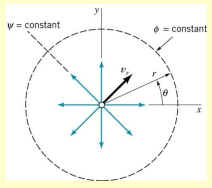A source is a point where fluid originates and spreads out radially in all directions. A sink is the opposite; fluid converges towards a point and is absorbed or removed from the flow.

is the volumetric flow rate per unit length perpendicular to the - plane. Qualitatively, it is the strength of the source/sink.
- For a source, (fluid is added)
- For a sink, (fluid is removed)
We can consider source and sink flows in terms of their radial and tangential velocity components, leveraging cylindrical coordinates.
Radial velocity component :
- decreases inversely with the radius ; the further we move from the source, the slower the speed.
Tangential component :
- There is no tangential velocity; the motion is purely radial.
The velocity components are gradients of the velocity potential and the stream function (see plane potential flows)
which in turn gives us the velocity potential as
- This tells us that equipotential lines () are concentric circles.
The stream function can be solved to be
- This tells us that streamlines are radial lines emerging from the source or converging to the sink, as expected.